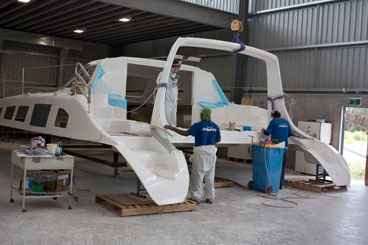
Seawind
Should you ever get asked to have a glass of wine, a bite to eat, and a look around Australia, I’d advise you to accept, as the first two should prove delicious and the latter quite interesting. Earlier this year, AIMEX, the Australian International Marine Export Group, hosted a tour for marine editors so we could get a look at the industry Down Under. Our travels began in Brisbane, where we spent two days tooling about the Gold Coast in an assortment of boats. From there, it was off to Sydney and then on to Melbourne before we wrapped things up with a two-day catamaran jaunt through the Whitsundays.
What was most striking, I thought, was the passion we found along these eastern and southern coastal locales for anything relating to the water, be it sailing, powerboating, surfing, windsurfing, kiteboarding, parasailing—you name it. What follows is a notebook recounting our travels, presented roughly in the order in which they unfolded.
A Long Ways Away
For visitors coming from the United States, there’s truly no easy way to get to Australia, which is worth considering when you think about what’s involved in exporting a sailboat or gear to the States or Europe: One literally travels to the other side of the world. Boats must be either sailed on their own bottoms or sent by ship, which in either case adds considerably to the cost. Gear manufacturers, such as Ronstan, have things a bit easier because airfreight is an option for them, but still they face supply and manufacturing costs that others elsewhere in the world might avoid. All Australian manufacturers in recent times, meanwhile, face a common challenge in that a high Aussie dollar compared to a low U.S. dollar has made exchange rates relatively unattractive. The fact that many do continue to compete for customers in North America indicates that to keep in the game, they’ve had to be innovative in their product development and efficient in their methods of production.
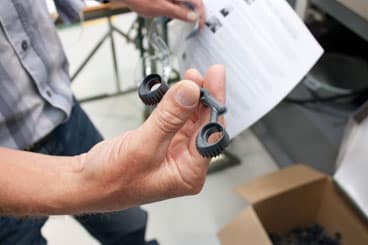
Cams for cam cleats (right) are molded at Ronstan.
Lightwave Yachts and the Marine Precinct
Our first visit after landing in Brisbane took us to Morton Bay, where we spent the afternoon aboard a Lightwave 38 catamaran. Rigged for charter, the boat proved to be a nimble sailer as we tacked and reached, often at seven knots or better in light winds, across the protected inshore waters. Morton Bay is a well-traveled body of water and part of an expansive and popular cruising ground that stretches north along the coast.
The next day, we returned to Lightwave and this time met Roger Overell, the founder and managing director of the company. Relatively unknown in the United States, where only one boat has been imported during the last 15 years, Lightwaves seemed to be common sights in Australia. At the time of our visit, Roger had just launched his 74th catamaran. The line includes 38- and 45-foot sailing cats, a 46-foot powercat, and a 47-foot motorsailer.
We headed out on one of the 45s and set sails in the Broadwater region, a waterway whose name we found quite deceiving. “Thinwater” might be more appropriate. The area consists of a number of channels that cut through large areas of shallows, all tucked behind a row of barrier islands. One must pay close attention to navigation buoys to stay out of trouble here. Though houses lined the mainland shores, lush islands were everywhere, providing what looked to be many fine anchorages.
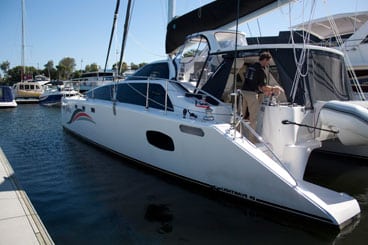
This Lightwave 45 catamaran features sleek lines and comes with a hot tub molded into the foredeck.
Lightwave, Roger said, has 25 employees and a plant in the Gold Coast Marine Precinct, where it built eight boats in 2010; the company was to launch 11 this year. As a hedge against slow times in the boat business, Lightwave also builds fiberglass septic tanks for a Japanese construction-supply company.
The day also included a tour of the Gold Coast City Marina, the anchor business in a nearly 700-acre marine manufacturing district located on the Coomera River, which provides nearby access to the Pacific Ocean. The marina itself has 200 berths and is surrounded by some 60 other facilities, ranging from small manufacturing and repair lofts to plants housing the likes of Riviera, Maritimo, Perry Catamarans, and Mercury Marine.
Said managing director Jeff Leigh-Smith, “At the end of the day, it’s really a shopping center for boat maintenance.”
Plans call for the precinct eventually to have berths for 1,000 boats as well as superyacht facilities. Precinct executives noted that 10 percent of the world’s superyachts make it across the Pacific, and the goal is to attract more than the current 2 percent or so that stop in the region for visits and repairs.
An Aquatic Playland
On a Saturday, we found ourselves back at Broadwater, with hoards of sail and powerboats seemingly everywhere: Owners were enjoying the sunshine and blue skies that bless Queensland 90 percent of the time. We spent the morning screaming up and down the Gold Coast’s offshore waters on big Riviera and Maritimo powerboats. OK, I’ll admit that this sailor found these sedans and cruisers to be a blast to drive. I’m not sure which dial on the instrument panel was more intriguing, the knotmeter or the gauge showing how much fuel we consumed each hour.
At lunch, we rafted up in a cove, surrounded by anchored sailboats, jet-skis, ski boats, and people all along the shore fishing, swimming, and enjoying a day off at the beach. I have no documentation to prove this, but I’d wager that boating ranks high as a national pastime.
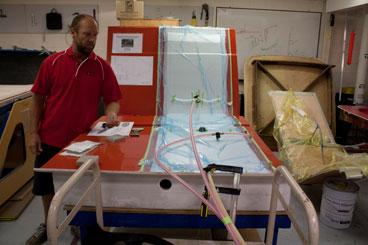
A worker at EMP, a composite design and manufacturing shop, monitors the flow of resin during the layup process. The company makes components for a wide range of products.
A View of the Opera House
Sunday found us in Sydney, where we began our tour of the famous harbor aboard a Stebercraft workboat built by Steber International, a 65-year-old boatbuilder that began working in fiberglass in 1959. The company’s boats are popular with fishermen and law-enforcement agencies, with several models in production.
More to my liking, the Stebercraft ferried us to an anchored Seawind 1160 catamaran. It was a hot, humid morning, and just as we stepped aboard the sailboat, the skies darkened, the wind went from a gentle breeze to a noteworthy blow in minutes, and the mercury plunged 20 degrees in a snap of one’s fingers. Though we hadn’t come looking for one, we saw first hand one of the famed Aussie southerly busters, the term that locals use for the fronts that pass along the coast. By the time reefed sails were set and the anchor was up, the wind had the harbor whipped to a froth of whitecaps. We flew past the Opera House on our harbor tour, during which we clocked a gust of about 40 knots across the deck. Around us, crews scrambled to shorten sails, but an impressive number of locals seemed to take it all in stride and remained out on the water.
Our stopover in Sydney included a visit to Sydney City Marine, a full-service superyacht marina that’s being developed in the heart of the city, as well as a look at the site where Seawind Catamarans plans to build a new service facility along 300 feet of city shoreline. The marina will include 18 multihull berths, refit and charter services, a café, a slipway, a commissioning facility, and a showroom.
That night in Sydney’s Chinatown, we watched the Chinese New Year parade, a festive procession that wove its way along pedestrian-lined streets. The selection of restaurants was staggering.
The Gear Guys
During our factory visits and at three evening events held at Sanctuary Cove, in Queensland; Sydney City Marine; and the Sandringham Yacht Club, in Victoria, we met the representatives of scores of small marine-related companies, which, taken together, constitute a vibrant home-grown industry that’s innovative in finding ways to sell products and services beyond the nation’s watery borders.
Aqualuma Marine Lighting is one such company that comes quickly to mind. Brothers Carl and Grant Amor, both with backgrounds in the automobile business, were restoring a boat when they discovered that they couldn’t find light fixtures to suit their fancy. From that somewhat vexing dilemma sprang a company that’s today well represented at boat shows around the world, where it sells a complete line of interior, deck, and through-hull L.E.D. lights. The brothers picked us up at our hotel in Sanctuary Cove one evening in a pair of very classic cars and took us to Carl’s nearby house (Grant lives just across the street) for an authentic and delicious Aussie barbecue. There were no shrimp.
We visited Aeronaut Automation, a company that few may have heard of but one that many of us can thank for the sails that power our boats. The company produces automated cutters and the software that drives them, and its client roster includes North, Quantum, Ullman, Sobstad, UK-Halsey, and Doyle. Aeronaut Automation’s machinery is used to build nearly all the string and laminate sails produced worldwide, company representatives said.
A much more common name in American markets is Ronstan, whose factory in Braeside was the largest manufacturing plant we visited. In fact, the company is the largest maker of marine fittings in the country, and its line of products—rigging, blocks, cams, clothing, wire fittings—can be found on boats ranging in size from dinghies right on up to 100-footers.
The company’s expanding product line now includes drum furlers, and just this fall, Ronstan introduced its recently acquired Andersen winches to North America. Ronstan is also a diversified company, manufacturing a line of architectural rigging. Its boating products are found in most U.S. marine stores, and the company maintains offices Stateside as well.
Ronstan was established in Melbourne in 1953 by dinghy sailors Ron Allatt and Stan Le Nepveu. Since 1999, it’s been owned by its management team, most of whom carry on that tradition of sailors building gear for sailors. Managing director Alistair Murray—currently AIMEX president—gave us a tour of the manufacturing plant, and he proved during lunch and later at a networking event to be an able spokesman on behalf of the Australian marine industry at large.
Another name you might recognize from American boat shows is Barz Optics. Company founder Kevin Barz is a former surfing champ who developed a line of specialty sport sunglasses for people working and playing on the water. Being a fellow, myself, who needs reading glasses to see chart and chart-plotter details, I can attest to the quality of his line of polarized bifocals.
Some of the coolest products we found in our travels came from a company called Sealite, which designs and manufactures intelligent aids to navigation for ships and airplanes. Its rotomolded navigation buoys use L.E.D.s and specially designed lenses for low-power consumption, and the buoys can be controlled remotely to adjust, say, the light’s period. As leading lights, they can be set, as they are when used for airport landing lights, to pulsate and guide a ship down a channel at night. They’re also used by the military in cases in which, perhaps, a darkened harbor might provide a tactical advantage at one time, while at others, the buoys must be lit for ship traffic.
Seawind Cats and Sporty Raceboats
As our trip around Australia continued, our hosts provided a couple of more goodies designed to pique a sailor’s interest.
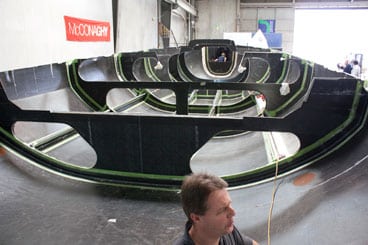
McConaghy workers prepare to dry-fit the deck on a new TP52 hull.
On the day we visited the McConaghy yard in Mona Vale, New South Wales, workers had just pulled Audi Racing’s new TP 52 hull, built entirely of carbon fiber and Nomex, from the 120-foot-long oven and were preparing to dry-fit the deck. This Judel/Vrolijk design, when we saw it, was squarely in fast-lane mode. Construction began the first week of January, and the company faced a ship-to-customer date so the boat could be in Europe by May for the lead up to the Audi MedCup. McConaghy is a world-renowned raceboat builder, and the company also has a yard in China, where it turns out a swarm of Moths each season, along with other custom projects and the McConaghy 38, a one-design racer. The company does luxury and quirky as well. It recently built an experimental boat for Aussie yachtsman Ian Oatley that has a keel that swings from side to side, rather than canting at the centerline. Photos of the boat, named Q, sailing closehauled show the keel and its bulb sitting well above the water to windward. McConaghy also builds a range of carbon wheels and other fittings, and it occasionally branches out to do repair work or take on non-marine projects, such as making acoustic panels for a concert hall or telescoping emergency ramps for trains.
We later paid a visit to Seawind Catamaran’s offices and the expanded manufacturing facility where it builds the Seawind 1000, 1160, and the new 1250 catamarans. (To read a review of the Seawind 1250, click here) On the shop floor with founder and managing director Richard Ward, we watched workers prepare to infuse an Airex-cored glass hull with resin; others were busy hand-laying a fiberglass deck and other components for assembly. Australia’s largest catamaran builder, Seawind relied until recently on overseas markets for a good chunk of its business. Exports to the United States, though, have been off due to exchange rates and the overall impact of the global financial crisis, which we’d hear about repeatedly during our visit. Still, Ward expected to build 24 boats this year and had plans to begin tooling for a smaller catamaran, the 950, which is designed to be disassembled and put into two containers for easier shipping.
Ward, whose company turns 30 this coming year, also recently purchased Corsair Marine, whose trailerable racy trimarans are manufactured in Vietnam. At the time of our visit, he was laying plans to build at least some Seawind components at his new facility to cut production costs. To build an 1160, Ward said, five big molds make up the structure of the boat, but there are 62 additional molds needed to complete it; it’s these he plans to make overseas in order to compete with lower-cost production cats being imported to Australia.
Tough Work, but Somebody’s . . .
Our Australian adventure all but over, two of us capped off the visit by flying north to Hamilton Island, in the Whitsundays. There we met Brent Vaughan, Seawind’s director of sales, for an overnight tour aboard a 1250 of the nearby islands that serve as a gateway to the Great Barrier Reef.
Privately owned Hamilton Island, with its resorts, high-end villas, marina, and other facilities, is where our visit began and ended. Lovely as the island is, the best awaited us outside the harbor, where we found nothing but white-sand beaches, uninhabited shorelines, protected anchorages, fine snorkeling, and even better sailing.
If the intent of our hosts at AIMEX was to leave us eager for more, they succeeded. As I said at the outset, if anyone offers you a glass of wine, a bite to eat, and a look at Australia, take them up on it. I know I’ll definitely be back.








